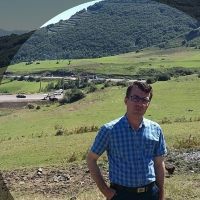Assessing the Eiciency of Arc-CN Runoff Tool in Runoff Estimation and its Comparison in 1996 and 2011 Years in Haraz Watershed, Mazandaran Province
Author(s):
Article Type:
Research/Original Article (دارای رتبه معتبر)
Abstract:
Introduction
Due to population growth and human activities and increasing water demand, water availability will be critical and water resource assessment and planning for sustainable use become more complex. The dynamic and long-term laws of runoff are important and have practical value for the sustainable development and planning of water resources. On the other hand, the traditional methods of runoff estimation should be improved regarding the accuracy and spatial variations. The application of GIS extensions is needed to provide water resource assessment data. Therefore, the application of such new techniques has greatly increased in recent years to estimate the runoff characteristics. The SCS method is the most commonly used method for estimating surface runoff, whose accuracy has improved through employing advanced GIS-based tools. The applicability of Arc-CN Runoff tool was tested in different internal and external studies which emphasized the quantitative evaluation of the model results.
Methodology
In this study, the accuracy of runoff estimation by Arc-CN Runoff tool was evaluated based on the land use map in two different time periods (1996-2011). The Landsat satellite images of 1996 and 2011 were processed and analyzed for land use mapping. Map of soil hydrologic groups was prepared in GIS environment using slope and soil texture maps. The annual rainfall calculations were done using rainfall daily data of several years for stations within the basin. The curve number map was used to estimate runoff using SCS method within ArcCN-Runoff tool in GIS environment. The runoff observations of Karehsang Station were calculated using daily flow data and the base flow was separated. Finally, the accuracy of the estimated runoff was assessed by estimating the percent relative error.
Results and Discussion
According to the accuracy assessment of land use maps using the ground-based map, the best overall accuracy and kappa coefficient were respectively 90% and 88%. The results showed that the maximum likelihood algorithm and the combination of main and synthetic bands, classified the land use classes of the study area with an acceptable accuracy. The highest percentage of the area was classified as range and dry farming (62.74%) in 2011. The percentage of rangeland, dense forest, and water zones decreased in 2011 compared with 1996.The map of the hydrological groups shown in this study, consisted of groups B, C and D, respectively covering 15.5, 44.5 and 40% of the study area. The average CN in the years 1996 and 2011 was estimated to be around 79.6 and 81.6.The average estimated rainfall of the study area using the arithmetic mean, inverse distance weighting, and kriging methods in 1996 were respectively 486.24, 424.4 and 486.1 mm. The estimated annual rainfall values were equal to 521.5 (arithmetic mean), 514.6 (inverse distance weighting) and 521.5 (kriging) mm. Runoff height was the highest in bare lands and residential uses, and the minimum of runoff height values were estimated in good and medium rangelands.
Conclusion
The mean values of total runoff, base flow, and surface runoff have increased in 2011 compared to 1996. The highest CN values in both periods consisted of bare lands and residential area. The runoff height in different land uses and the total runoff height increased in 2011 (11.38 mm) compared to 1996 (8.8 mm), which can be partly due to the degradation and land use change. The results of this study showed that the ArcCN-Runoff tool improved the accuracy of potential runoff estimations, while the relative error of runoff estimation in both periods was relatively low and acceptable. Thus, the implemented tool can be used to assess and estimate runoff height. The results showed that the relative error of runoff estimation in both periods was in agreement and the error amount was relatively low (10%). In addition, the used methods and tools were evaluated with 90% accuracy in both periods and can be used for runoff estimation in data-scarce watersheds.Keywords:
Language:
Persian
Published:
Hydrogeomorphology, Volume:4 Issue: 16, 2018
Pages:
139 to 158
magiran.com/p1920789
دانلود و مطالعه متن این مقاله با یکی از روشهای زیر امکان پذیر است:
اشتراک شخصی
با عضویت و پرداخت آنلاین حق اشتراک یکساله به مبلغ 1,390,000ريال میتوانید 70 عنوان مطلب دانلود کنید!
اشتراک سازمانی
به کتابخانه دانشگاه یا محل کار خود پیشنهاد کنید تا اشتراک سازمانی این پایگاه را برای دسترسی نامحدود همه کاربران به متن مطالب تهیه نمایند!
توجه!
- حق عضویت دریافتی صرف حمایت از نشریات عضو و نگهداری، تکمیل و توسعه مگیران میشود.
- پرداخت حق اشتراک و دانلود مقالات اجازه بازنشر آن در سایر رسانههای چاپی و دیجیتال را به کاربر نمیدهد.
In order to view content subscription is required
Personal subscription
Subscribe magiran.com for 70 € euros via PayPal and download 70 articles during a year.
Organization subscription
Please contact us to subscribe your university or library for unlimited access!




